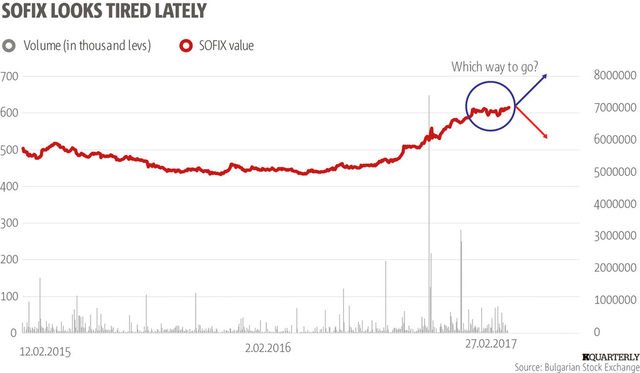It was three years back when the fourth biggest bank collapsed in Bulgaria and the country's benchmark SOFIX stock index last saw levels above 600. Now, cautious all-clear signals after the stress tests and asset quality reviews of banks, pension and insurance companies contributed to improvement of investor confidence last year. Economic growth rates of around 3% - not seen since before the Global Financial Crisis - also provided local investors with reasons to cheer in 2016. Yet, this year can also prove profitable - with lending picking up, cost of credit low and employment and income rising, the domestic environment seems supportive.
On the international front, Russian sanctions do not seem to curb growth, and rising commodity prices help emerging markets, which in turn boost the EU's economy through trade in high value-added sectors. Then why is the SOFIX stuck in a narrow 20-points range at the beginning of 2017?
There are several plausible explanations. Dizziness after the wild ride last year that saw the SOFIX jump 27%, with most of the rise taking place in the last quarter, might be the dominant. Others include digestion of earnings season announcements and technical consolidation below the highs of 2014. But more is found if we dig deeper. Political issues overshadow economic progress once again. Yet another caretaker government will be followed by elections in Bulgaria with polls pointing to no clear winner, which makes it almost certain that yet another broad coalition will be formed. This means more of the same old slow, if any, reforms. A look beyond our borders isn't pretty either. To the south we have Greece on the verge of default, Turkey with nationalist agenda and shaken foreign investor confidence. To the southwest and north we have political instability and protests in Macedonia and Romania. In short, not the best neighborhood.

When we speak of elections we must not forget the upcoming vote in the Netherlands and France in the next couple of months, and in Germany later in the year. The drift towards nationalism and anti-EU moods has been an issue in the past few years. Dutch voters are probably less likely to show any clear Brexit-like sentiment, and if history is any guide, neither will France after the second round, even if Mrs. Le Pen wins the first one.
Still, we need to see the all-clear signs before being comfortable with the political background in Europe. Germany will probably introduce changes to its open-door refugee policy to dispel the sour mood in its society. This is my base scenario and if it materializes, it will be a solid pillar for the Bulgarian economy and financial markets in 2017. Regretfully, it will not be enough.
Back in December, when rating agencies typically update their views on the Bulgarian economy, the political uncertainty probably was the only solid reason for not getting an investment grade rating back from Standard and Poor's. While people might argue that this has been the new normal in the last couple of years, we have to agree that we could have been even better off with the perks that come with full investment grade rating and political stability, namely ready and willing foreign investors and positive mood of local managers.
But don't take my word for it - just look at what Romania, our usual peer in the minds of politicians, did in growth terms in the last few years, while enjoying all of the abovementioned. Our neighbor to the north recorded 3.5%, 3.1% and 3.9% real GDP growth in 2013, 2014 and 2015 respectively, while Bulgaria's was 0.9%, 1.3% and 3.6% in the same period, according to Eurostat data. Projections for the three years through 2018 are also not in our favor, with growth rates of 4.9%, 4.4% and 3.7% for Romania, respectively and 3.3%, 2.9% and 2.8% for Bulgaria, according to the same source.
In conclusion, it seems that the old saying "Help yourself so that God can help you" will fit perfectly into our situation, which is a good thing to remember inside the election booths. As reasonable human beings, of course, we should hope for the best but be prepared for the worst. Investors in Bulgaria should be ready for volatility in both directions. It is a tough call from here but I would bet we would be out of the narrow range mentioned earlier by the end of the second quarter.
And I would be open-minded in both scenarios. Positive developments will eventually lead to levels above the 2014 highs and this will attract sidelined investors, probably fueling another double-digit percentage rise in 2017. The negative scenario will also present opportunities. Any fall in prices might entice those hesitating where to put their money with more attractive valuations. After all, with zero or negative interest rates shares are still the lesser evil.
Ivaylo Penev CFA, Portfolio Manager and Board Member, ELANA Fund Management
It was three years back when the fourth biggest bank collapsed in Bulgaria and the country's benchmark SOFIX stock index last saw levels above 600. Now, cautious all-clear signals after the stress tests and asset quality reviews of banks, pension and insurance companies contributed to improvement of investor confidence last year. Economic growth rates of around 3% - not seen since before the Global Financial Crisis - also provided local investors with reasons to cheer in 2016. Yet, this year can also prove profitable - with lending picking up, cost of credit low and employment and income rising, the domestic environment seems supportive.
On the international front, Russian sanctions do not seem to curb growth, and rising commodity prices help emerging markets, which in turn boost the EU's economy through trade in high value-added sectors. Then why is the SOFIX stuck in a narrow 20-points range at the beginning of 2017?












